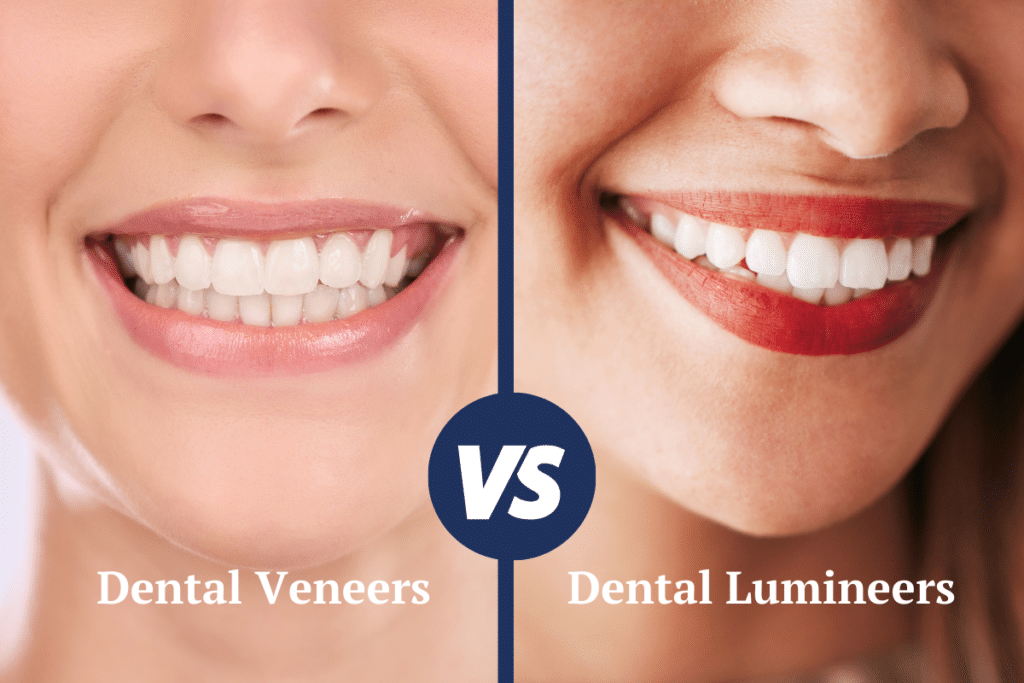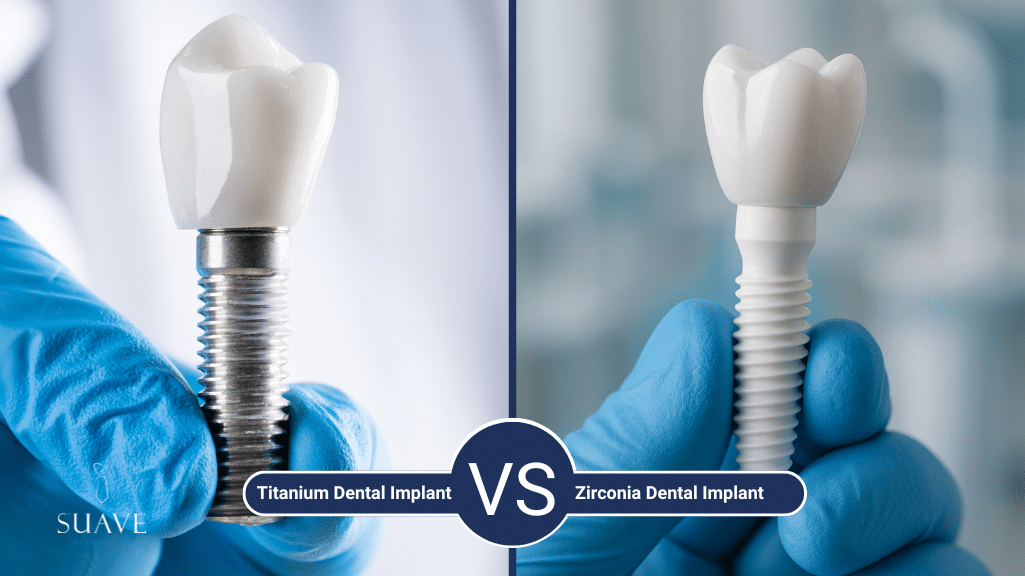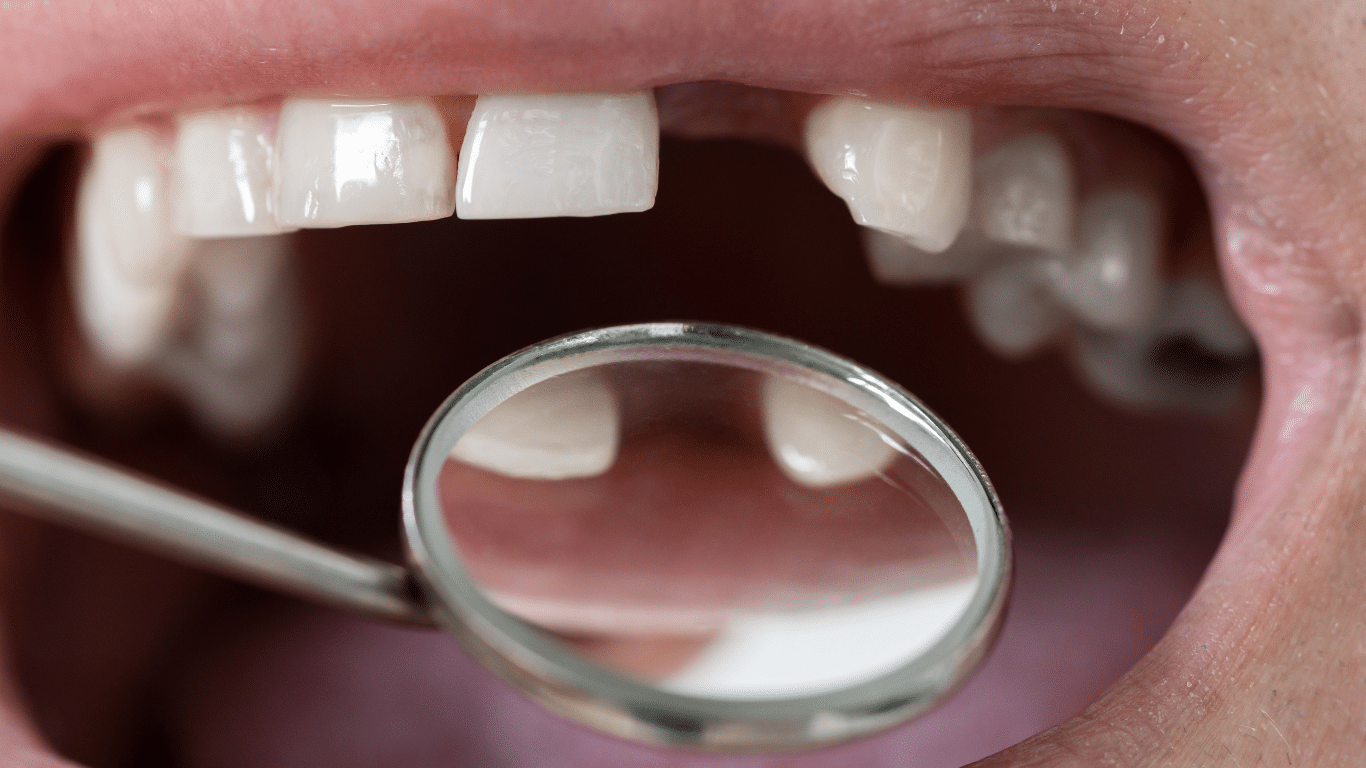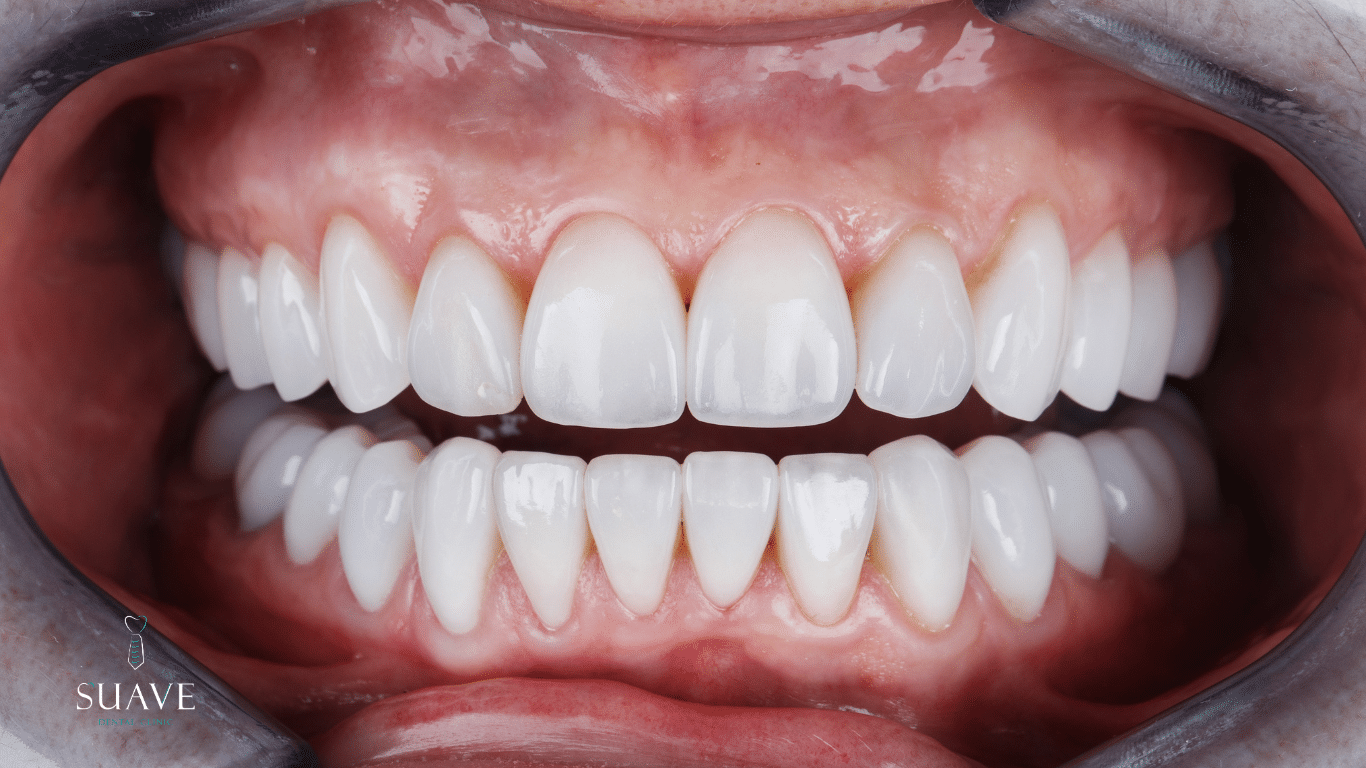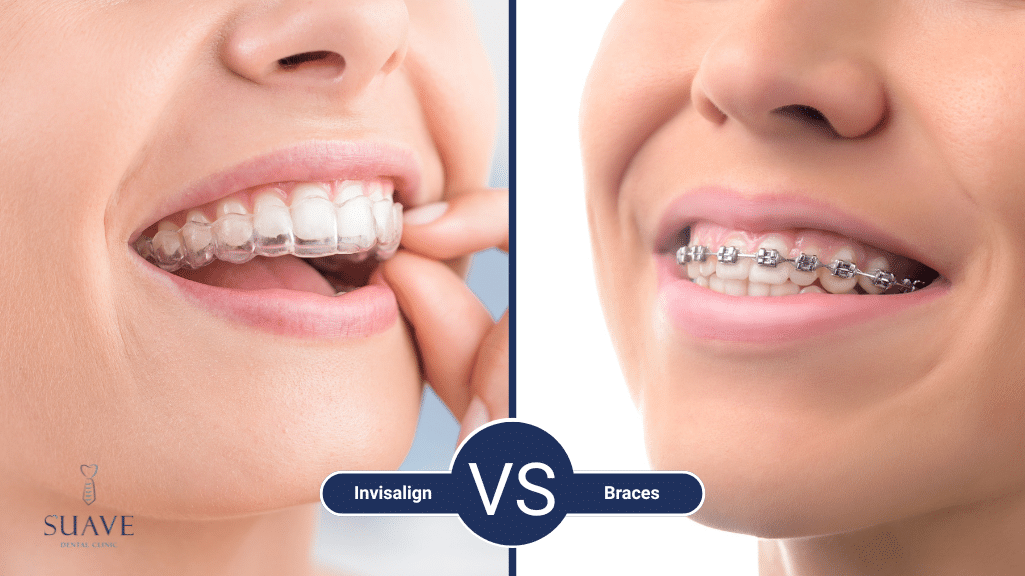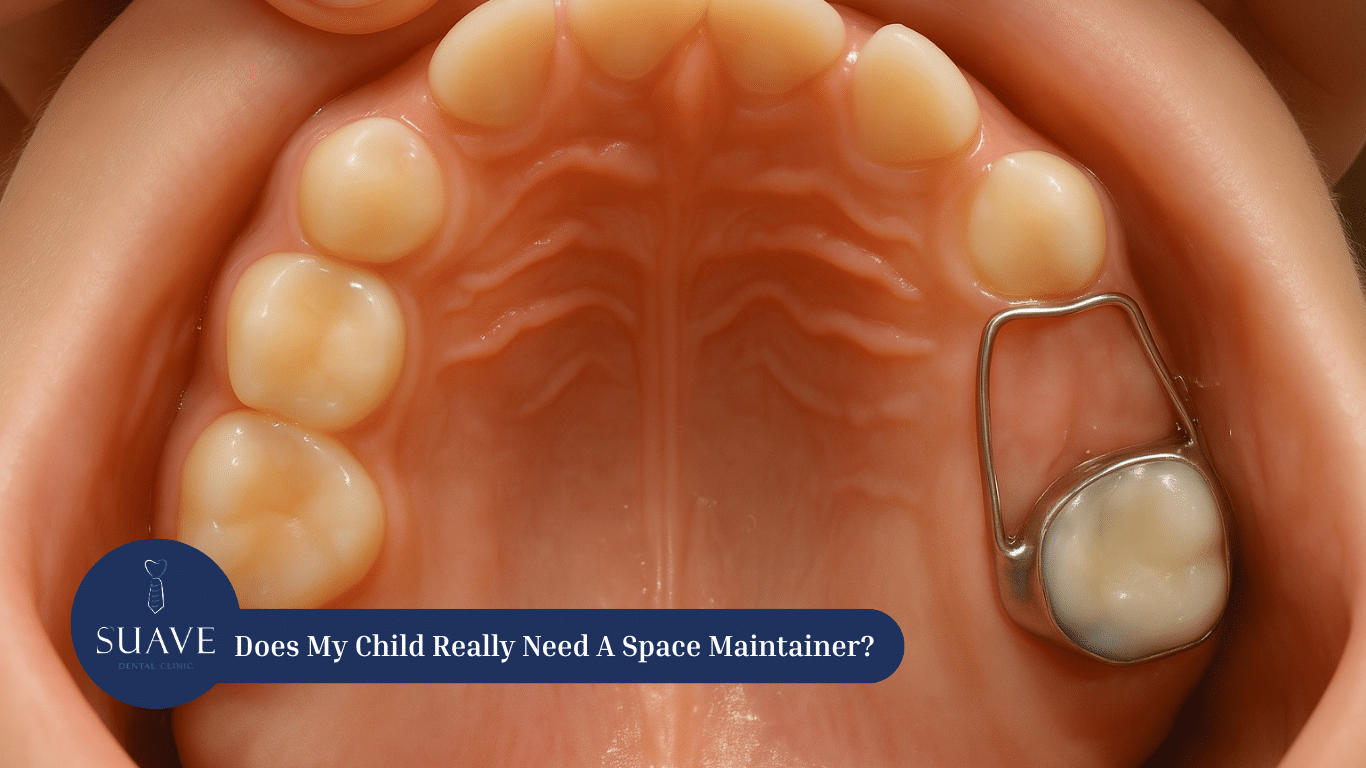If you are seeking a permanently white naturally-looking smile makeover, that is long-lasting and heart-stealing, then your dental treatment plan should either consider traditional dental veneers or dental Lumineers.
Both Lumineers and veneers offer excellent ways to improve your smile, but the best option for you depends on your specific needs and goals. At Suave Clinic, we specialize in cosmetic dentistry and are here to help you decide which one to choose lumineers vs veneers
The key differences between veneers and Lumeneers
While veneers and Lumineers share many commonalities, the key differences lie in how they are applied, their thickness, and the potential effects on your natural teeth.
1. Thickness
- Veneers: Traditional veneers are about 0.5 mm to 1mm thick, which is thicker than Lumineers.
- Lumineers: Lumineers are ultra-thin, about 0.2 mm thick.
2. Opacity
- Veneers: due to their thickness, are considered to be more opaque than Lumineers and in extensive cases could require an underneath Opaquer layer to hide the amount of tooth restoration or severe discoloration
- Lumineers: Dental lumineers are ultra-thin highly translucent porcelain layers that can’t hide severe teeth anomalies underneath as they reflect the enamel shades, considered the highest translucent dental restoration that covers the front teeth.
3. Teeth Removal
- Veneers: due to their thickness, the amount of teeth structure removed or shaved while teeth preparation is more than teeth preparation for Lumineers.
- Lumineers: Dental lumineers are ultra-thin that require minimal teeth removal and it’s more conservative than in most cases don’t require teeth removal at all, and are called (no-prep lumineers)
4. Aesthetic results
- Veneers: veneers offer more aesthetic correction for several cases of dental anomalies like badly decayed teeth, large amounts of restoration, extensive malalignment, and discoloration that’s why it’s the most applicable solution in most cases.
- Lumineers: cases indicated for dental Lumineers are quite limited due to their high translucent ultra-thin thickness that can’t hide a lot of dental anomalies as traditional dental veneers, so it’s most use cases are: mild to moderate discoloration and white patches after orthodontic treatment, small diastemas and gap closure, mild cracked chopped anterior teeth.
5. Reversibility
- Veneers: it’s an irreversible dental procedure as the amount of teeth structure removed in order to traditional veneers placement is irreversible, so it can’t be removed without covering up the prepared teeth with restorations.
- Lumineers: in cases of no-prep Lumineers, it’s reversible and can be removed while the underneath tooth structure remains intact.
6. Permanency
- Veneers: it’s a permanent smile makeover that covers the front teeth of the anterior and premolar teeth.
- Lumineers: it’s permanent but it could be removed if the patient is willing to.
7. Durability
- Veneers: veneers are highly durable long-lasting smile makeover prostheses and they are more durable than the Lumineers with high fracture and retention strength, they could last for 15-20 years with good oral hygiene, regular dental checkups, and proper care.
- Lumineers: lumineers also are a long-lasting restoration that reaches 10-15 years by avoiding any tear and shear force and maintaining good oral hygiene.
8. Cost
- Veneers: are typically more expensive than Lumineers due to the additional steps involved in the procedure, including enamel removal, the use of temporary veneers, and the customization process.
- Lumineers: Lumineers tend to be more affordable on average, at Suave Clinic, turkish Lumineers start at $280 per tooth, because they don’t require as much tooth preparation or temporary acrylic veneers.
9. Dental Process Application
- Veneers: it takes more than one dental visit, in the best case scenarios it could take 2- 3 visits, in severe cases, it could take longer according to the treatment plan of the patient case.
- Lumineers: Lumineers tend to be placed directly in the patient’s mouth in a single visit, if the dental unit has in-unit CAD CAM, in most cases, it takes just 2 dental visits without any requirement of temporary veneers.
We talked about the 10 most distinguished differences you should consider if you want to take a step toward a smile makeover or Hollywood smile and get a more highly attractive naturally looking white smile. There are also some similarities that dental veneers and Lumineers have in common.
Check out Best Veneers Brands For Perfect Smile!
Similarities Between lumineers vs veneers
- Purpose:
Both veneers and Lumineers are used to improve the appearance of teeth and incorporate them into a smile makeover treatment plan. They are both considered the number #1 solution for permanent whiter nice well-shaped teeth, and both contribute to a more confident smile and increased self-esteem. - Material of Fabrication:
Both veneers and Lumineers are all ceramic porcelain restoration to mimic the translucency and the shading of Enamel tooth structure. There are other materials like porcelain veneers, However, All ceramic or Emax materials are the best and the most durable and long-lasting in the market.
- Placement:
Both options involve bonding a thin layer of porcelain to the front teeth to cover up any discoloration or malformation.
- Stain Resistance:
Both veneers and Lumineers are highly resistant to stains. Their surfaces do not easily absorb pigments from coffee, tea, or wine, helping your smile stay smooth, bright, and white for years.
What to Choose: lumineers vs veneers?
When deciding between veneers and Lumineers, both options offer incredible transformations for your smile. Consultation with professional dentists to examine your teeth, and your smile condition and then assess your esthetic needs will help you set your goal based on a scientific reasonable treatment plan.
As we discussed above both dental porcelain laminates and traditional veneers are the #1 solution for a smile makeover but each has the situations that are mostly indicated.
- Veneers: Traditional veneers offer a better solution for patients with severe discoloration, misalignment, or dental imperfections. They are thicker and provide better coverage for damaged teeth.
- Lumineers: If you are looking for a minimally invasive option that preserves most of your natural tooth structure, Lumineers may be more suitable, especially if you have mild discoloration.
It’s important to note that the final decision should always be guided by your dentist’s professional assessment, there is no room for personal preference. Only a dentist can evaluate your dental health and determine your esthetic needs.
Lumineers vs Veneers FAQs
Which Looks More Natural, lumineers vs veneers?
Veneers might offer more coverage and the ability to hide more imperfections for a more natural-looking smile, as we discussed above both mimic the natural smile:
Lumineers: These are ultra-thin and translucent, which allows the natural tooth color to shine through. And in mild to moderate imperfections it can create a beautiful, natural smile.
Veneers: Due to their thickness and ability to cover severe discolorations and imperfections. They can achieve a highly natural look for more complex dental cases.
Do Celebrities Get Veneers or Lumineers?
Most celebrities get dental veneers for permanent naturally looking Hollywood Smile, as this is the optimum way for permanent whiter nicer teeth that hide all the imperfections and cover up most of the irregularities. Veneers are the more common choice among celebrities due to their versatility and durability for the reasons we discussed above.
- Demirekin, Z. B., & Turkaslan, S. (2022). Laminate veneer ceramics in aesthetic rehabilitation of teeth with fluorosis: a 10-year follow-up study. BMC Oral Health, 22(1). https://doi.org/10.1186/s12903-022-02079-4
- Albanesi, R. B., Pigozzo, M. N., Sesma, N., Laganá, D. C., & Morimoto, S. (2016). Incisal coverage or not in ceramic laminate veneers: A systematic review and meta-analysis. Journal of Dentistry, 52, 1–7. https://doi.org/10.1016/j.jdent.2016.06.004
- Arif, R., Dennison, J. B., Garcia, D., & Yaman, P. (2019). Retrospective evaluation of the clinical performance and longevity of porcelain laminate veneers 7 to 14 years after cementation. Journal of Prosthetic Dentistry, 122(1), 31–37. https://doi.org/10.1016/j.prosdent.2018.09.007
- Alenezi, A., Alsweed, M., Alsidrani, S., & Chrcanovic, B. R. (2021). Long-Term survival and complication rates of porcelain laminate veneers in clinical studies: a systematic review. Journal of Clinical Medicine, 10(5), 1074. https://doi.org/10.3390/jcm10051074
- Watson, K. (2023, April 18). Veneers vs. Lumineers: What’s the Difference? Healthline. https://www.healthline.com/health/veneers-vs-lumineers#takeaway
